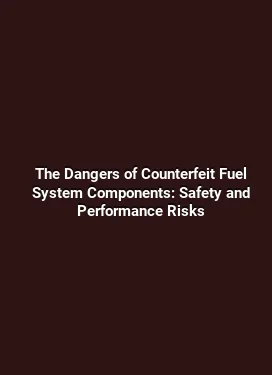How to Calculate Air-Fuel Ratio for Maximum Power and Safety
Foundations of Air-Fuel Ratio in Intake & Fuel Systems

The air-fuel ratio (AFR) is a fundamental parameter that governs how an internal combustion engine converts fuel into usable power. In modern engines, the intake system, fuel delivery network, and exhaust feedback work in unison to maintain a precise balance between air and fuel under varying operating conditions. A well-managed AFR ensures efficient combustion, maximizes torque, reduces emissions, and protects components from excessive heat or knock. To understand how to calculate and implement the ideal AFR for your setup, it is essential to examine the main actors in the intake and fuel system, including mass air flow measurements, injector characteristics, fuel pressure behavior, and sensor feedback loops that guide real-time adjustments.
At the core, the AFR reflects the chemical reaction between air and fuel during combustion. While a stoichiometric mixture (approximately 14.7 parts air to 1 part fuel by mass for typical gasoline) is ideal for complete combustion under idle and light-load conditions, performance-oriented objectives often push toward a richer or leaner mixture depending on rpm, load, and cooling capabilities. The intake system shapes the amount of air entering the engine, while the fuel system controls the quantity of fuel delivered for each intake stroke. Understanding how these subsystems interact lays the groundwork for precise AFR calculations and dependable tuning strategies that can be replicated across different engines and configurations.
Key Components Influencing Air-Fuel Ratio

Various elements influence the AFR in dynamic operating envelopes. Mass air flow sensors translate the volume and density of incoming air into electrical signals that the engine control unit (ECU) uses to determine baseline fueling. In response, the injector(s) deliver a calibrated amount of fuel; the injector flow rate, spray pattern, and closing speed all impact the final mixture. Fuel pressure stability and rail design determine how consistently the prescribed amount of fuel is available for atomization. The intake manifold, throttle body, and associated tubing shape the charging efficiency and effect the actual air mass that participates in combustion. Each subsystem contributes to the accuracy and repeatability of AFR calculations across engine loads and speeds.
Engine feedback mechanisms, such as oxygen sensors in the exhaust stream and temperature sensors in the intake and coolant circuits, provide real-time data that refine AFR estimates. The goal is to keep the mixture within safe bounds that prevent pre-ignition or excessive combustion chamber temperatures while enabling the engine to produce peak power without compromising reliability. In performance-oriented setups, operators often adopt tuning strategies that consider transient conditions, such as sudden throttle inputs, gear changes, or rapid accelerations, to preserve the intended AFR curve under all driving scenarios.
Methods to Measure Air-Fuel Ratio Accurately
Accurate AFR measurement requires a combination of sensors and diagnostic practices. In-cylinder pressure sensors and wideband oxygen sensors (lambda sensors) are commonly used to capture instantaneous oxygen content and fuel equivalence. A wideband sensor provides a broader range of readings than a traditional narrowband sensor, enabling finer discrimination across lean and rich conditions. When interpreting measurements, it is important to account for sensor response time, calibration status, and temperature effects, which can introduce short-term fluctuations that look like abrupt AFR changes but reflect sensor dynamics rather than true engine behavior.
For bench testing or on-vehicle tuning, a data-logging approach that captures AFR alongside RPM, load, throttle position, and air temperature yields the most actionable insights. Plotting AFR against volumetric efficiency or torque output reveals how the engine responds to different fuel maps and intake configurations. In high-performance contexts, transient AFR events may occur during gear shifts or rapid acceleration; recognizing these transient behaviors helps in refining the fuel map to avoid lean spikes or over-rich bursts that can harm performance or safety margins.
Optimizing AFR for Maximum Power
Achieving maximum power involves pushing the engine to extract the most fuel-energy conversion possible without compromising reliability. This requires deliberate tuning of the AFR curve across the engine’s operating range, with a focus on maintaining stable combustion, controlling exhaust gas temperatures, and ensuring sufficient cooling under high-load conditions. A key concept is that the optimal AFR for peak power is often slightly richer than the stoichiometric point at high load, where additional fuel helps suppress engine knock and manages cylinder temperatures, especially under aggressive ignition timing and elevated boost scenarios.
When chasing peak power, it is common to see a dynamic shift in AFR desires across RPM bands. Low to mid RPM under heavy load may tolerate a richer mixture to boost torque and mitigate heat generation, whereas high RPM operation demands careful fuel economy and thermal management to preserve engine integrity. The intake system’s ability to supply air at a given pressure and density directly affects how much fuel can be burned efficiently. If air intake temperatures rise or turbocharger or supercharger boost is introduced, the AFR must adapt to keep combustion stable while extracting the intended power gain.
Tuning Techniques and Practical Examples
Effective tuning starts with establishing a baseline AFR map that respects the engine’s physical limits and manufacturer recommendations. A practical approach is to define a target AFR curve that is slightly richer under high-load, high-boost, and high-torque regions while maintaining a safer, near-stoichiometric condition at cruise or light-load conditions. This strategy helps balance power output with engine durability. In practice, tuning often involves adjusting injector pulse width, nozzle spray patterns, and fuel pressure within the tolerances of the fuel system to achieve the desired fuel delivery at each operating point.
Consider an engine with a multi-point or direct injection system where each cylinder has individualized control. By aligning the AFR with cylinder-specific demands, you can address disparities caused by intake runner length, port geometry, or thermal gradients. It is crucial to verify that the measured AFR remains within safe bounds across the full RPM spectrum, not just at a single operating point. A robust approach uses a combination of steady-state maps and transient testing to ensure reliable performance during throttle transitions and gear shifts. This methodology helps avoid lean spikes or rich bursts that can degrade power consistency or cause detonation under certain conditions.
Practical Considerations for Intake & Fuel System Upgrades
Upgrades to the intake path, such as larger throttle bodies, improved intake plenum designs, or higher-flow air filters, influence the air supply and, consequently, the AFR. With more air entering the engine, the ECU must compensate by delivering additional fuel to preserve the intended mixture. Similarly, enhancements to the fuel system—such as higher-flow injectors, upgraded fuel pumps, or refined pressure regulation—must be matched with precise fueling strategies to achieve the desired AFR while avoiding fuel starvation under high-demand events.
Another practical factor is fuel quality and octane rating. Higher octane fuels resist knock more effectively, allowing for more aggressive ignition timing and potentially leaner mixtures at certain loads. Understanding how different fuels impact the safe operating window is essential when finalizing AFR targets. Additionally, cooling strategies, such as charge air cooling and intercooling, can enable denser air intake and alter the AFR requirements for the same power output. Monitoring these interactions helps maintain consistent performance and safety margins across varying operating conditions.
Safety Considerations and Real-World Scenarios
Safety in AFR management means ensuring the engine operates within thermal and mechanical limits while delivering the desired performance. Excessively lean mixtures can lead to high combustion temperatures, piston damage, and valve issues; overly rich mixtures can cause fuel dilution, incomplete combustion, and increased exhaust emissions. A balanced approach considers the engine’s cooling capacity, ignition timing strategy, and the endurance limits of components such as spark plugs, pistons, and exhaust systems. When experimenting with AFR, use incremental changes, validate with data logging, and observe engine sounds, temperatures, and knock indicators before proceeding to further adjustments.
In real-world driving scenarios, the AFR should remain stable under different loads and speeds, from steady highway cruising to rapid acceleration. Transient behavior, such as a sudden load increase or a downshift, requires the ECU to adapt the fueling quickly without causing a disturbance in power delivery or a transient lean/rich spike. The use of staged fueling strategies, including deceleration fuel cut or lean burn techniques in select operating windows, can further optimize performance while maintaining safety margins. A disciplined testing routine, paired with robust data analysis, reveals how close the actual AFR tracks the target map and where adjustments are necessary to preserve reliability in daily usage as well as high-demand situations.
Cool-Down and Post-Tuning Verification
After adjusting AFR targets, it is important to verify the system’s response during cool-down periods and extended operation. Engine temperatures, exhaust gas temperatures, and sensor health should be monitored to ensure that the changes do not introduce unintended stress. Post-tuning verification should include a comprehensive test drive that traverses the vehicle’s full operating envelope, capturing data across idle, part-throttle, and full-throttle regimes. Consistent readings across multiple sessions increase confidence that the AFR strategy will perform predictably in varied conditions.
Integrating AFR Management into a Holistic Intake & Fuel Strategy
A robust approach to AFR optimization considers the entire intake and fuel ecosystem. This includes air filtration efficiency, intake runner design, manifold geometry, and the interplay between air density and fuel vaporization. The goal is to establish a coherent map where air supply, fuel delivery, ignition, and exhaust all align to deliver predictable power while safeguarding longevity. By embedding AFR considerations into a broader performance plan—covering air filtration, throttle response, and turbocharger or naturally aspirated configurations—engine builders can create setups that respond effectively to dynamic driving demands.
In practice, this means documenting the targets for each operating cell, validating sensor readings under diverse temperatures, and maintaining a clear record of hardware changes that influence AFR. The resulting system should provide repeatable power curves, stable torque delivery, and consistent fuel economy within acceptable ranges for the intended use. By embracing a methodical, data-driven approach to AFR tuning within the intake and fuel framework, enthusiasts and professionals can realize meaningful gains in both performance and reliability.
Final Notes on Implementation and Best Practices
Successful AFR optimization combines precise measurement, careful component selection, and thoughtful mapping that accounts for the engine’s physical limits and operating goals. The practice of iterating in small steps, validating with real-world data, and respecting safety boundaries yields the most reliable outcomes. Incorporating sensor calibration checks, maintaining clean fuel delivery paths, and ensuring stable electrical and vacuum systems all contribute to a robust AFR strategy that supports both maximum power and long-term engine health.





